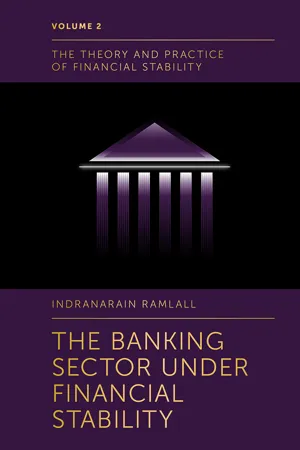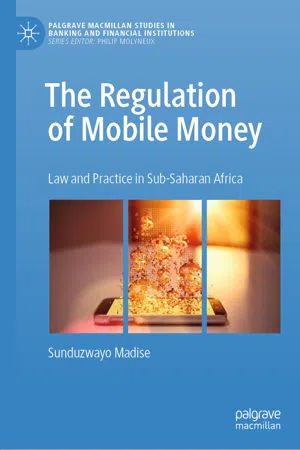Economics
Types of Financial Regulation
Financial regulation encompasses various types of rules and laws designed to oversee and control the activities of financial institutions and markets. These regulations can be categorized into different types, such as prudential regulation, conduct regulation, and market regulation. Prudential regulation focuses on ensuring the stability and soundness of financial institutions, conduct regulation aims to protect consumers and investors, and market regulation seeks to maintain the integrity and efficiency of financial markets.
Written by Perlego with AI-assistance
Related key terms
Related key terms
1 of 4
Related key terms
1 of 3
5 Key excerpts on "Types of Financial Regulation"
- eBook - ePub
- Indranarain Ramlall(Author)
- 2018(Publication Date)
- Emerald Publishing Limited(Publisher)
- Fiscal and monetary policies tend to be procyclical, thus adding fuel to fire. However, macroprudential policies also require monetary policy as complementary tools.
- Thus, macroprudential regulation becomes important to ensure that financial institutions do have more capital than what the institutions believed to be enough to bear any undesired risks. How is this achieved? Well, macroprudential regulation takes on a broader aspect of the financial system by giving due consideration to systemic risks.
Despite rekindling motives for macroprudential regulation in the light of the US subprime crisis, yet such a regulatory approach existed decades ago. Indeed, in the 1970s and 1980S, the IMF and the OECD encouraged economies to remove macroprudential controls in view of liberalising both their capital and current accounts. The aim of regulation is to prevent monopoly power and externalities and also to avoid information asymmetry. The purpose of regulating banks is to ensure that they have enhanced asset quality, they have proper level of capital requirements and that they have established a sound deposit insurance scheme. The 2007/2008 financial crisis sent a strong message to policy-makers worldwide whereby the conventional view that the safety of individual financial institutions guarantees the safety of the whole gamut of the financial system should be considered with a grain of salt. This implies the need to call for macroprudential regulation, a general equilibrium condition compared to the partial equilibrium framework embedded in microprudential regulation.6.7. Three Types of Data for Macroprudential Approach
Macroprudential data need to be complete, accurate and timely. Macroprudential data can emanate from various sources such as macroeconomic data, domain intelligence, banking data, experience and judgment information, amongst others. Domain intelligence encompasses market, policy and institutional intelligence. There are four dimensions of data, namely entities data, data over years (time dimension), variables (macroeconomic) and data which link different entities. Time series data need to be stationary to ensure proper econometric applications. Stationarity itself is of a dual nature-trend stationarity or stochastic stationarity. Cross-sectional data need to be cleaned of any feasible heterogeneity problem. Many problems may creep in data analysis. For instance, outliers and skewed distributions can distort on sound data analysis. Data may suffer from publication lags. There may be reporting errors. Besides, Schou-Zibell, Albert, and Song (2010) pointed out that the use of weighted averages of indicators may reduce their accuracy. Moreover, indicators which are useful in one economy may not be useful in another economy. In addition, there may be missing or incomplete data. Quantitative data may not be sufficient so that it needs to be complemented with qualitative data in spite of the fact that qualitative data are difficult to quantify in practice. For instance, it is a hard nut to crack when it comes to assessing the quality of banking supervision. Large data collected may not necessarily imply good data. Furthermore, the fact that financial markets change quickly implies that data may quickly become obsolete. It is important to note that the quality of any model is dependent on the quality of the data. - eBook - ePub
The Regulation of Mobile Money
Law and Practice in Sub-Saharan Africa
- Sunduzwayo Madise(Author)
- 2019(Publication Date)
- Palgrave Macmillan(Publisher)
© The Author(s) 2019 Sunduzwayo Madise The Regulation of Mobile Money Palgrave Macmillan Studies in Banking and Financial Institutions https://doi.org/10.1007/978-3-030-13831-8_4Begin Abstract4. Different Types of Regulation
Sunduzwayo Madise1(1) University of Malawi, Zomba, MalawiEnd AbstractKeywords
Regulation Regulatory capture Regulatory continuum Regulatory space Regulatory spectrum4.1 Introduction
The term regulation refers to a set of binding rules issued by a private or public body.1 In its most generic form, it represents an “intervention between the parties to a transaction”.2 Fleuriot says that regulation aims at the maintenance of a balance or equilibrium and the task of the regulator is to maintain the various balances among the different actors.3 Ogus refers to regulation as the “sustained and focused control exercised by a public agency over activities that are valued by a community”.4 These are “obligations imposed by public law designed to induce individuals and firms to outcomes which they would not voluntarily reach”.5 It is the threat of some form of punishment or sanction that underpins regulatory enforcement.6 In relation to economic activities, one of the motivations for putting in place regulations is market failure .7 It is trite that a pinnacle tenet of a free market is to leave it to regulate itself and find its own equilibrium. Yet, there will be times when the market may fail to do this, either due to exogenous or endogenous shocks or factors. The reason why the market usually will want less regulation is that it is perceived as an economic cost. According to Dumez and Jeunemaitre , “regulation will be preferred to laissez faire whenever the cost of regulation is less than the transaction costs due to regulation plus the market failure costs”.8Different societal systems will have different regulatory standards and objectives. For the financial sector, three things are associated with the need for regulation: correcting information asymmetry, maintaining trust in the financial system and avoiding systemic risk or contagion .9 All these are considered public goods.10 In most economic enterprises, there is information asymmetry between the consumers and the suppliers in favour of the latter.11 This is more so where consumers are dealing with institutions that have a network or web of interconnected ties, which the average consumer cannot fathom.12 Statutory requirements obliging suppliers to disclose information related to their service or product are part of this correction.13 Apart from consumer interests, there are also state interests at play such as ensuring system security and good financial management. Trust is a prerequisite for consumers to procure the service.14 To gain trust, a system must be seen to be working in a fair and an orderly way.15 - eBook - ePub
- Jin Cao(Author)
- 2021(Publication Date)
- Routledge(Publisher)
PART IV The economics of banking regulationPassage contains an image
CHAPTER 11 Systemic risks and macroprudential regulation
DOI: 10.4324/9780429356773-1511.1 Introduction
11.1.1 Why Is Banking Regulation Special?
Banks, as firms in other industries, are subject to regulation. Compared with other industries, banks are rather heavily regulated, for reasons which are probably obvious. As we have shown in the previous chapters, banks eliminate financial frictions and improve social welfare, and banks also create failures that cannot be solved by themselves. Therefore, in principle, regulation is needed wherever banks fail to discipline themselves: regulators must create and enforce the rules of game for all banks, making sure that all banks comply with legal requirements on their businesses; regulators must prevent banks from abusing their market power to extort their competitors and customers, as well as maintain necessary market competition; regulators must correct market failures due to asymmetric information as well as punish fraud and deception, and so on.However, compared with regulation in other heavily regulated industries such as telecommunications, banking regulation is also made different, by special characteristics in financial intermediation and the strategic status of banking industry in the economy. Banking regulation is particularly distinguished by several features:- The main outcome of banking regulation is an extremely desirable public good: financial stability. As banks are among main providers of financial resources to the real economy, a well-functioning banking system is a foundation for a well-functioning economy. As is shown in Chapter 8
- Stephany Griffith-Jones, Ricardo Gottschalk, Stephany Griffith-Jones, Ricardo Gottschalk(Authors)
- 2016(Publication Date)
- Routledge(Publisher)
2 Financial regulation, stability and growth in low-income countries A review of the evidence and agenda for research Stephen Spratt IntroductionFor many low income countries, especially in Africa, financial regulation policies constitute the foundation basis for the mechanisms through which financial development exerts a positive impact on economic growth and poverty reduction.(Murinde, 2012)Without effective regulation, financial systems become unstable, potentially triggering crises with devastating effects on the real economy. The continuing impacts of the global financial crisis of 2007–8 show how large these can become. While the avoidance of crises is a necessary condition for productive economic activity to flourish, it is not sufficient. Another more positive side to regulation is one which shapes the evolution of financial structures and influences the ways in which financial actors serve the real economy. The purpose of regulation is thus twofold: to maintain financial stability and to promote inclusive economic growth. Achieving the right balance between these objectives is a delicate, but crucial task. Too great a focus on stability stifles growth, while a headlong dash for growth is very likely to sow the seeds of future crises.The structures of low-income countries’ (LICs) real and financial sectors are different to those in developed countries. Institutional capacity to implement certain kinds of financial regulation is also generally lower. Therefore, the set of regulatory instruments best able to maximise growth, while maintaining stability, should also be different.While this has always been broadly accepted in principle – if rarely in practice – the global financial crisis highlighted a more fundamental issue. Given what we learnt about ‘sophisticated’ finance, it is simply no longer tenable to view the regulatory practices that evolved in the world’s major financial centres as a model to which developing countries should aspire. As regulatory options continue to be re-assessed in developed economies, the time is ripe to do the same in developing countries in general, and LICs in particular.- eBook - ePub
Investment and Portfolio Management
A Practical Introduction
- Ian Pagdin, Michelle Hardy(Authors)
- 2017(Publication Date)
- Kogan Page(Publisher)
Authorization of companies or individuals will involve an element of thorough research into the background and history and may be dependent upon reaching a minimum level of qualifications or prescribed standards of conduct. The precise method and intensity of monitoring will depend upon the level of risk posed by the company or individual, the perceived likelihood of breaching the rules/regulations, the potential consequences of a breach in the rules/regulations and the supervising agency’s resources. Any enforcement procedures may occur for a variety of reasons including the supervisor’s monitoring activities, or a complaint by a customer or another market participant. Enforcement procedures would usually involve some form of investigation to determine exactly what has occurred, the root cause and if further action or sanction is required. The supervising agency may employ the use of enforcement officers with powers to investigate and to gather information. It may be that there is an agency which is appointed with the responsibility for monitoring compliance and the identification of suspected rule breaking, but a separate agency has the responsibility to determine if the suspicion is proven and if so, to apply an appropriate penalty, sanction or impose compensation.Regulation in financial markets
It is generally accepted that the operations of the financial markets are pivotal in the development of any economy and the financial sector is the mechanism which facilitates the exchange of goods and services in the economy and to transfer the savings of an economy into investments. A sound, efficient and well-managed financial sector will accomplish this process, encouraging more savings and therefore more investment in the process. This should result in faster economic growth, improved levels of income and therefore the end result should be the improvement of well-being domestically, within the economy. Strong and efficient domestic financial markets may also be of significant benefit to global growth in the form of investment capital movement from wealthier, more developed economies, to emerging and developing economies.It has been mentioned earlier in the chapter that one of the reasons for robust regulatory regimes being so important is the issue that information asymmetry exists, within the finance sector, between the sellers of financial products and the buyers. Generally, most markets work well when there is a high frequency of repeat purchases of a given product, because in these market circumstances, it is quite straightforward for an individual to determine the inherent quality of the product. It is also easy for the individual to switch away from a poor quality product to a product of better quality and not to make the same error in the future.
Index pages curate the most relevant extracts from our library of academic textbooks. They’ve been created using an in-house natural language model (NLM), each adding context and meaning to key research topics.
Explore more topic indexes
Explore more topic indexes
1 of 6
Explore more topic indexes
1 of 4




